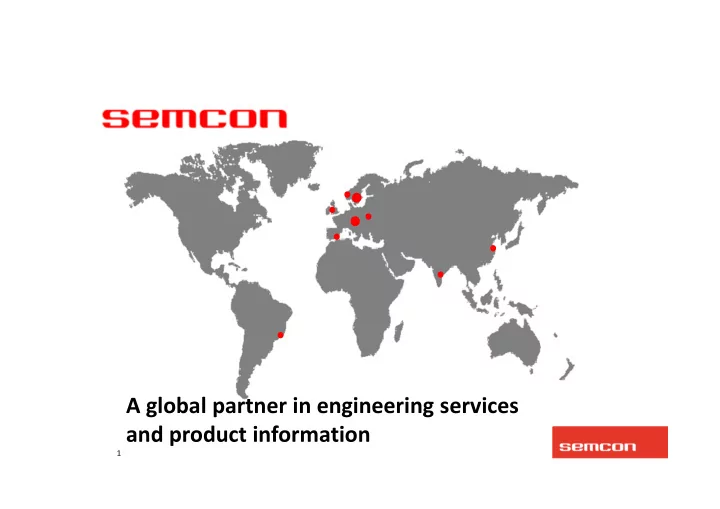

A global partner in engineering services and product information 1
Turbulent dispersion modelling in RANS Federico Ghirelli Gothenburg region OpenFOAM user group meeting November 14, 2012
SIMPLEST POSSIBLE EXPERIMENT: Point source in steady homogeneous turbulence The fluid in position X 0 is marked with a tracer at time t 0 . Several realizations give the average tracer concentration field (or pdf of particle position). The dispersion of the tracer is characterised by the standard deviation σ (t) of the concentration. 3
Turbulent diffusion coefficient for the point source in steady homogeneous turbulence The standard deviation σ develops as: (Taylor 1921) Turbulent diffusivity is related to σ : (after proper assumptions) Experimental data shows the autocorrelation function is well approximated by this function: Finally, the turbulent diffusion coefficient can be expressed as: Dotted and dashed curves: default RANS models in commercial CFD 4 Effect of correlation
Time scale of the vortex shedding behind a cylinder D D 5 5 τ = ≈ = τ VORTEX SHEDDING FLOW StV V Is this time scale negligible ?? 5
Analytical solutions and generality Pulse in homogeneous turbulence: � � � � � �� � � �1 � � � � � Plume in homogeneous turbulence U>>u’: � � � � � �� � � �1 � � �� � � In these cases diffusivity is an explicit function of independent variables (x or t). Clearly, this is not suitable in general-purpose models, because it implies that the unknown of the problem (D), is partly or entirely given before the solution of the problem. Nonetheless, the FSC model uses such functions in order to account for the effect of correlation (more on the FSC in following slides). 6
My approach, no independent variables Point source in homogeneous turbulence or plume in homogeneous Plume in decaying turbulence turbulence 7
Premixed flame modelling TFC model FSC model � Does not account for � Accounts for velocity velocity correlation correlation � Implemented in Ansys � D t,t and U t,t are explicit Fluent functions of time (or � Usually applied to stabilized position) flames � Implemented in Ansys Fluent � Usually applied to spark ignited flames A better model should: � Account for velocity correlation � Include no explicit dependence on t or x � Be applicable to both kinds of flames � Satisfy the L&C test for premixed flame models 8
My model of premixed flame, validation and comparison Moreau burner: flame stabilized by a pilot flame Volvo test: bluff body stabilized flame V-flame: Stabilized by a wire 9
Premixed flame model, achievements: � Accounts for velocity correlation, � No explicit functions of t or x, � Satisfies fully the test of L&C, � Performs well in inhomog. turbulence, � Performs better than TFC model, � No need for calibration constant A !!! � No need for calibration of ScT !!! 10
Dispersion with default RANS modelling When modelling dispersion with default RANS models, it is necessary to calibrate Sc T . Recommended values of Sc T vary from 0.2 to 1.3 (usually 0.7 in premixed flame apps.) Is Sc T needed (at least in part) because velocity correlation is neglected? 11
Dispersion modelling, potential applications: � Mass transport (mixing, pollution, etc.) � Heat (turbulent heat transport) � Momentum (turbulent viscosity) � Turbulence (turbulence modelling) Dispersion model, limitation: � Single deterministic source (example: in the dispersion of flames from two non-simultaneous sparks, the model looses accuracy.) 12
What now? Dispersion model: � New idea for resolving the ”single source” limitation, relatively simple implementation in OpenFOAM. Premixed flame model: � Comparison between the FSC – my flame model. Carried out by Ehsan Yasari, PhD student at Applied Mechanics in Chalmers, under the supervision of A. Lipatnikov, author of FSC model. 13
Conclusion Significant improvements were achieved in RANS modelling of turbulent dispersion. More results are coming soon (hopefully). Thank you for your attention! 14
Recommend
More recommend